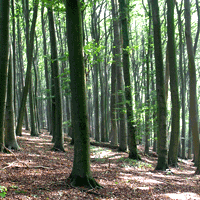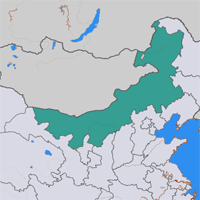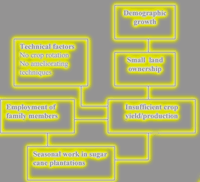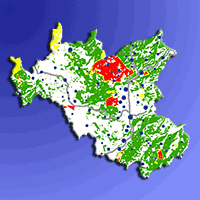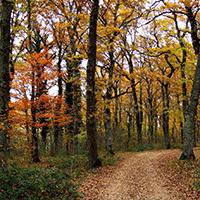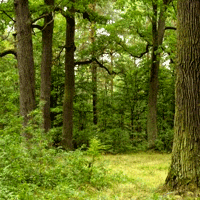
Deforestation, land conversion and illegal logging in Bangladesh: the case of the Sal (Shorea robusta) forests
iForest - Biogeosciences and Forestry, Volume 5, Issue 3, Pages 171-178 (2012)
doi: https://doi.org/10.3832/ifor0578-005
Published: Jun 25, 2012 - Copyright © 2012 SISEF
Technical Reports
Abstract
Bangladesh, with a forest cover estimated at 17.08% of all land surface area, has experienced massive degradation of its natural resources and a considerable change in its land cover. While deforestation in Bangladesh is obviously a complex issue, one important aspect emerges from previous research findings in explaining deforestation: industrialization. This study focuses on the causes of deforestation in Bangladesh, particularly in tropical moist deciduous Sal forests, using multi levels factor analysis framework. Data were collected through questionnaire surveys, formal and informal discussions with local people, expert interviews and literature reviews. The main findings of deforestation framework show that illegal logging and forest land conversion were the ultimate causes of Sal forests deforestation in Bangladesh. Illegal logging is a complex phenomenon and is being patronized by a local syndicate, functioning from behind the scenes. On the other hand, land conversion into different commercial activities has direct influence on national policy and the predisposing conditions of this country. Therefore, the immediate task of the nation would be to stop illegal logging and land conversion of Sal forests. This can be done by involving all relevant stakeholders in the form of effective forest policy formulation and execution of strict environmental protection law.
Keywords
Sal Forests, Deforestation, Land Tenure, Forest Policy, Corruptions
Authors’ Info
Authors’ address
Corresponding author
Paper Info
Citation
Islam K, Sato N (2012). Deforestation, land conversion and illegal logging in Bangladesh: the case of the Sal (Shorea robusta) forests. iForest 5: 171-178. - doi: 10.3832/ifor0578-005
Academic Editor
Renzo Motta
Paper history
Received: Jan 27, 2011
Accepted: Apr 12, 2012
First online: Jun 25, 2012
Publication Date: Jun 29, 2012
Publication Time: 2.47 months
Copyright Information
© SISEF - The Italian Society of Silviculture and Forest Ecology 2012
Open Access
This article is distributed under the terms of the Creative Commons Attribution-Non Commercial 4.0 International (https://creativecommons.org/licenses/by-nc/4.0/), which permits unrestricted use, distribution, and reproduction in any medium, provided you give appropriate credit to the original author(s) and the source, provide a link to the Creative Commons license, and indicate if changes were made.
Web Metrics
Breakdown by View Type
Article Usage
Total Article Views: 96076
(from publication date up to now)
Breakdown by View Type
HTML Page Views: 74469
Abstract Page Views: 5608
PDF Downloads: 14060
Citation/Reference Downloads: 85
XML Downloads: 1854
Web Metrics
Days since publication: 4917
Overall contacts: 96076
Avg. contacts per week: 136.78
Citation Metrics
Article Citations
Article citations are based on data periodically collected from the Clarivate Web of Science web site
(last update: Mar 2025)
Total number of cites (since 2012): 47
Average cites per year: 3.36
Publication Metrics
by Dimensions ©
Articles citing this article
List of the papers citing this article based on CrossRef Cited-by.
References
Summary of the social forestry programs of the Bangladesh Forest Department. The Bangladesh Agroforestry Newsletter 9: 1-2.
Gscholar
Underlying causes of deforestation and forest degradation in Bangladesh. A report submitted to Global Forest Coalition (GFC), the Netherlands.
Gscholar
Statistical year book of Bangladesh. Bangladesh Bureau of Statistics, Government of people’s Republic of Bangladesh, Dhaka, Bangladesh.
Gscholar
Statistical pocket book, Bangladesh.Bangladesh Bureau of Statistics, Government of Bangladesh, Dhaka, Bangladesh.
Gscholar
The underlying causes of forest decline. Occasional Paper No. 30, CIFOR, Bangor, Indonesia.
Gscholar
Forest resources assessments 1990: Global Synthesis: FAO forestry paper, 124, Rome, Italy.
Gscholar
FRA 2000 forest resource of Bangladesh country report. Food and Agriculture Organization, Rome, Italy.
Gscholar
Forest management. Forestry master plan. UNDP/FAO BGD 88/025.I, Ministry of Environment and Forests, Government of Bangladesh, Dhaka, Bangladesh.
Gscholar
The last forest of Bangladesh. Society for Environmental and Human Development (SEHD), Dhaka, Bangladesh.
Gscholar
Stolen forest. Society for Environmental and Human Development (SEHD), Dhaka, Bangladesh.
Gscholar
West Africa: resource management policies and the tropical forest. In: “Public policies and the misuse of forest resources” (Repetto R, Gillis M eds). Cambridge University press, Cambridge, UK, pp. 299-352.
Gscholar
Bangladesh: road network improvement and maintenance project II. Ministry of Communication Roads and Highways Department, Dhaka, Bangladesh.
Gscholar
Conversion of dipterocarp-dominat natural forests to short rotation plantations- an unrecoverable threat to the native dipterocarps in Bangladesh. APAFRI, Malaysia.
Gscholar
A political economy of forest resource use: Case studies of social forestry in Bangladesh. Ashgate Publishing Ltd. Aldershot.
Gscholar
Deforestation in the Napo Basin: socio-economic factors, metrics, and patterns. M.Sc. Dissertation, Environmental Studies Department, Florida International University, Miami, FL, USA.
Gscholar
A study on land tenure complexities of Sal (Shorea robusta) forests in Bangladesh. International Journal of Agriculture and Biology 7 (2): 318-320.
Gscholar
Forest resources management. Field document No. 2, UNDP/FAO GBD/85/ 011, Institute of forestry, Chittagong University and FAO, Rome, Italy.
Gscholar
Deforestation: problems, causes, and concerns. In: “Managing the world’s forest” (Sharma NP ed). Kendal/Hunt publishing, Iowa, USA.
Gscholar
Macroeconomics causes of deforestation: barking up the wrong tree? In: “The causes of tropical deforestation: the economic and statistical analysis of factors giving rise to the loss of tropical forests” (Brown K, Pearce DW eds). University College London Press, London, UK.
Gscholar
The economics of deforestation: the example of Ecuador. MacMillan and St. Martin Press, St. Anthony’s College, London, UK, pp. 262.
Gscholar
Living Planet Report 1998: overconsumption is driving the rapid decline of the world’s natural environments. WWF, Gland, Switzerland.
Gscholar
An econometric model for deforestation in Indonesia. Working paper in Economics and Development Studies No. 200903, Department of Economics, Padjadjaran University, Indonesia.
Gscholar



